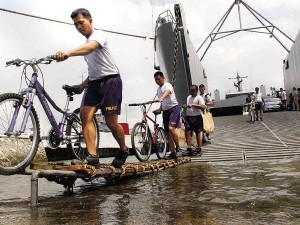Bicycle sales rise in post-Ondoy Marikina—city official
MANILA, Philippines—The number of bicycles sold after tropical storm “Ondoy” in 2009 was reported to have increased “abruptly” in flood-prone Marikina, prompting a high-ranking city official to say that the residents’ experiences during the storm made them change their view of the bicycle as a recreational tool.
Gabriel Eusebio, head of the city’s Bikeways Office, said based on a survey he conducted, the sales of bicycles in the shoe capital in the period from post-“Ondoy” 2009 to 2011 increased by “around 200 percent” from the figure registered from 2007 to pre-“Ondoy” 2009.
He said the “abrupt” increase in sales post-“Ondoy” was registered as a result of a high demand for bicycles then.
He came to the conclusion upon an analysis of the prices of each vehicle after the storm.
According to him, for a while after “Ondoy,” the price of each unit was the same as the price at which a bicycle was sold before “Ondoy.”
Article continues after this advertisementDuring that time, he said a brand new bicycle could be as “cheap” as P1,500.
Article continues after this advertisementThe most expensive one, he said, “did not reach (the price of) P100,000.”
“But the prices gradually increased (in the later part post-“Ondoy,”)” he said.
When prices finally stabilized in the second part after the storm, he said the cheapest bicycle was sold at P3,500, and the most expensive one at P200,000.
“So why would the prices (of bicycles) increase (in the later part post-“Ondoy”)? High demand (for bicycles). It’s the law of supply and demand,” he said, adding that based on the survey, residents even continued to buy bicycles despite the increase in the prices of each unit.
To further boost his theory about the connection between “Ondoy” and preference for the bicycle, Eusebio said the number of cycling organizations in the city also “doubled” after the storm.
From the five organizations existing in the city pre-“Ondoy,” he said the number increased to 10.
“That means ‘Ondoy’ was the turning point,” he said, adding that the residents who purchased the bicycles after the storm must have also joined these organizations.
So what is it about “Ondoy” that explains these new data?
For Eusebio, the answer is simple: The storm, which left almost the entire city underwater, enabled residents to develop a different view of the bicycle: from a mere tool for recreation, it is now viewed as a “necessity.”
He said residents must have seen that the two-wheel vehicle was a crucial mode of transportation when streets were flooded.
While users of four-wheel vehicles were left paralyzed during “Ondoy,” he said bikers could still somehow move about.
“You could just carry the bike if needed, unlike the car, which was automatically submerged underwater,” he said, adding the bicycle did not have an engine and was therefore “economical.”
He theorized residents also saw that even when streets were destroyed, the bike was still a handy companion.
“Unlike the four-wheel vehicle…You can use the bike in those instances. Kahit trackway, pwede yan,” he said.
Celso San Pascual of Barangay Sto. Domingo seemed to confirm Eusebio’s theory.
According to San Pascual, who was a participant to the cycling event Cambio Del Mundo: Padyak para sa Kalikasan last week, after “Ondoy,” he became “more appreciative” of his bicycle, which he had had since he was a boy.
“I’ve been biking for fun even when I was a kid, but after ‘Ondoy,’ I saw how useful my bike was,” the 54-year-old said.
He said when the storm struck, the vehicle had helped him move from one flooded street to the other.
It was “obvious” the bicycle was the “better vehicle” when “Ondoy” hit, he said.
“The bike was more useful than the car I think. You didn’t need to worry about your engine because (the bicycle) has no engine,” he said.
